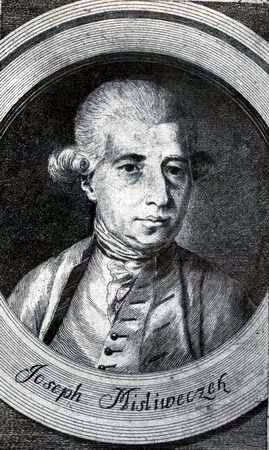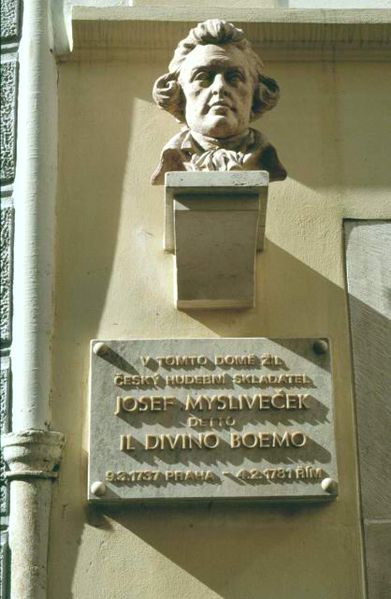<Back to Index>
- Biochemist Emil Abderhalden, 1877
- Composer Josef Mysliveček, 1737
- Tsar and Great Prince of All the Russias Aleksey Mikhailovich Romanov, 1629
PAGE SPONSOR


Josef Mysliveček (March 9, 1737 – February 4, 1781) was a Czech composer who contributed to the formation of late eighteenth century classicism in music. Mysliveček provided his younger friend Wolfgang Amadeus Mozart with significant compositional models in the genres of symphony, Italian serious opera, and violin concerto; both Wolfgang and his father Leopold Mozart considered him an intimate friend from the time of their first meetings in Bologna in 1770 until he betrayed their trust over the promise of an operatic commission for Wolfgang to be arranged with the management of the Teatro San Carlo in Naples. He was close to the Mozart family and there are frequent references to him in the Mozart correspondence.
Mysliveček was born in Prague, one of twins who were sons of a prosperous mill owner, and studied philosophy at Charles - Ferdinand University before following in the footsteps of his father. No
documentation exists to support claims that he was actually born in
Horní Šárka, a rural district to the north and west of
Prague in the early eighteenth century. He achieved the rank of master
miller in 1761, but gave up the family profession in order to pursue
musical studies. In Prague, he studied composition with Franz Habermann and Josef Seger in the early 1760s. His ambitions led him to travel to Venice in 1763 to study with Giovanni Pescetti.
His travel to Italy was subsidized in part from family wealth, in part from the Bohemian nobleman Vincenz von Waldstein. In Italy he became known as Il Boemo ("the Bohemian") and also "Venatorini", "the little hunter", a literal translation of his name. Reports that he was known as Il divino Boemo during his lifetime are false. The nickname originated from the title of a romanetto about the composer by Jakub Arbes that was first published in 1884. He was made a member of the Accademia Filarmonica di Bologna in 1771. Mysliveček prized freedom of movement and was never employed directly by any noble, prelate, or ruler, unlike most contemporary composers. He earned his living through teaching, performing, and composing music, and frequently received gratuities from wealthy admirers. Financially irresponsible throughout his life, he died destitute in Rome in 1781. He is buried in the church of San Lorenzo in Lucina, where a memorial placed by latter - day Czech admirers can be seen. No trace has ever been found of a memorial in marble supposedly erected shortly after his death by James Hugh Smith Barry, a wealthy English student of Mysliveček who paid for his funeral expenses. After his arrival in Italy in 1763, Mysliveček never left the country except for a visit to Prague in 1767 - 68, a short visit to Vienna in 1773, and an extended stay in Munich between December 1776 and April 1778. His return to Prague led to the production of several of his operas. He was invited to Munich by the musical establishment of the Elector Maximilian III Joseph to compose an opera for the carnival season of 1777 (Ezio).
Mysliveček's first opera, Semiramide, was performed at Bergamo in 1766 (there is no evidence that a putative production at Parma of an opera titled Medea ever took place). His Il Bellerofonte was a great success in Naples after its first performance at the Teatro San Carlo on 20 January 1767, and it led to a number of commissions from Italian theaters. Ever after, his productions would almost always feature first rate singers in the leading roles. Almost all of his operas were successful until a disastrous production of Armida that took place at the Teatro alla Scala in Milan for the carnival season of 1780.
Mysliveček
never married and no names of lovers are recorded. There is no
documentation to support reports of romantic liaisons with the singers Caterina Gabrielli and Lucrezia Aguiari; no mention of love affairs with these singers pre-dates the publication of the fifth edition of the Grove Dictionary of Music and Musicians (1954). In 1770 Mysliveček met the young Wolfgang Amadeus Mozart in Bologna. He
was close to the Mozart family until 1778, when contacts were broken
off after he failed to make good on a promise to arrange an opera
commission for Mozart at the Teatro San Carlo in Naples. Earlier, the
Mozarts found his dynamic personality irrestisible. In a letter to his
father Leopold written from Munich on October 11, 1777, Mozart
described his character as "full of fire, spirit and life."
Similarities in his musical style with the earlier works of Mozart have
often been noted. Additionally, Mozart used musical motives drawn from
various Mysliveček compositions to help fashion opera arias, symphonic
movements, keyboard sonatas, and concertos. He also made an arrangement
of Mysliveček's aria "Il caro mio bene" (from the opera Armida of
1780). The old text was replaced with the new text "Ridente la calma",
KV 152 (210a), in a scoring for soprano with piano accompaniment. According
to the same letter of Wolfgang Mozart written from Munich on October
11, 1777, an incompetent surgeon burned off Mysliveček's nose while
trying to treat a mysterious illness. A letter of Leopold Mozart to
his son of October 1, 1777, refers to the illness as something shameful
for which Mysliveček was deserving of social ostracism. Mysliveček's
reputation for sexual promiscuity, Leopold's insinuations, and the
reference to facial disfigurement in Wolfgang's letter hint
unmistakenly at the symptoms of tertiary syphilis. Mysliveček's explanation for his condition to Wolfgang -- bone cancer caused
by a carriage accident — is on the face of it preposterous. The concern
Mozart revealed to his father at this time for Mysliveček's sufferings
was very touching. In the entire Mozart correspondence, no individual
outside the Mozart family was ever the cause for so much outpouring of
emotion as what is found in Wolfgang's letter of 11 October 1777. In all, he wrote twenty - six opere serie, including the aforementioned Il Bellerofonte. Nearly all were successful at their first performances until the diasaster of Armida at La Scala during
carnival of 1780. Some of the irregularities that doomed this
production were not Mysliveček's fault, however, for example the
interruption of performances caused by the lying-in of the prima donna Caterina Gabrielli, who gave birth in the middle of the run out of wedlock at the age of 49. During the period of his activity as a composer of operas (1766 – 1780), Mysliveček succeeded in having more new opere serie brought
into production than any other composer in Europe. It also significant
to note that in the same period, more of his works were performed at
the Teatro San Carlo in Naples, the most prestigious venue in Italy at
that time for productions of serious opera, than those of any other
composer. Nonetheless, his contributions to Italian operatic culture of
the 1760s and 1770s have been almost universally ignored by opera
historians. Mysliveček and Gluck were the first composers raised in the Czech lands to
become famous as operatic composers, but their output exhibits few, if
any, Czech characteristics. Mysliveček's operas were very much rooted
in a style of Italian opera seria that prized above all the vocal artistry to be found in elaborate arias . Among his other pieces were oratorios, symphonies, concertos, and chamber music, including some of the earliest known string quintets composed
with two violas. His Op. 2 string quintets were almost certainly the
earliest string quintets with two violas ever published. Additionally,
he was a pioneer in the composition of music for wind ensemble, the outstanding examples of which are his three wind octets. It may be fair to say that his greatest composition is the oratorio Isacco figura del redentore, first performed in Florence in
1776. His violin concertos are perhaps the finest composed between the
generation of Vivaldi and the Mozart violin concerto of 1775. He was
also one of the most gifted and most prolific composers of
eighteenth century symphonies, although his contributions to this genre
have been ignored by musicologists in western Europe and North America
almost as completely as his operas have been. Nearly all of
Mysliveček's symphonies are cast in three movements without a minuet,
following Italian traditions that originated in opera overtures. His
opera overtures are also cast in three movements and were frequently
performed as independent instrumental pieces. In the 1770s, he was the
finest symphonist resident in Italy, and the esteem he enjoyed is
reflected in the issuance of a set of symphonies (originally opera
overtures) published by Ranieri del Vivo in Florence that was the first anthology of symphonies ever printed in Italy. Mysliveček's
compositions evoke a gracious, diatonic style typical of Italian
classicism in music. His best works are characterized by melodic
inventiveness, logical continuity, and a certain emotional intensity
that may be attributable to his dynamic personality.